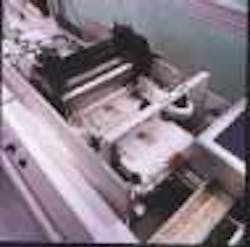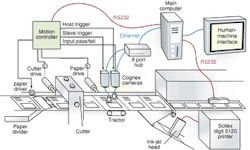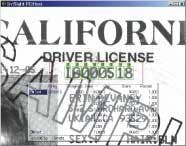Vision system issues driver's licenses
After receiving an order from the California Department of Motor Vehicles (DMV; Sacramento, CA) to design and build a driver's license card-issuing and mailing system (LMS), PowerForward (Toronto, ON, Canada) developed a stand-alone card-mailing machine that handles card products made by any card manufacturing technique and using any card material. The vision system reads the magnetic stripe on each card, verifies its details against a database, prints a personalized letter, attaches the card, and performs a 100% visual inspection (see Fig. 1). The system also cuts and folds the card carrier, adds other inserts as required, and seals the contents into a conventional business envelope at 7200 mailings per hour.
According to Kevin Quinn, president of PowerForward, "This modular system reads, verifies, and personalizes carriers at high speed, while providing security and card reconciliation. It has been designed to produce 50 million card mailings in the next eight years, but is built to produce more than 85 million, if needed," he says.
Depending on the modules selected, the LMS can use ink-jet or laser printers, incorporate an in-line vision inspection system, perform different folding styles, accumulate multiple pages, add selective inserts, and seal the contents into an envelope that is ready for mailing. Every system has card-control software to check and verify that the operations for each license are fulfilled. If there is a problem, the system will reject the item in question, record the error for later operator intervention, and still maintain production at rated speed. The LMS can read American Association of Motor Vehicle Administrators (Arlington, VA) standard encoding, track-2 encoding, or all three Hi-Co or Lo-Co tracks for those issuers who encode complete name and address information on the stripe. The system also can be easily modified to read 2-D barcodes or microprocessor chip cards.
System design
At the start of the production line, pre-encoded cards are fed through two magnetic card-reader heads from MagTek (Carson, CA) in serial fashion. "In this way," says Aaron Curtin, an electronics engineer with PowerForward, "the data on each card are read twice, and the system ensures that data are properly encrypted on each card." The TTL voltage outputs from these reader cards are then detected by a microcontroller. Proprietary software takes the data from the driver's license cards—which includes name, postal address, and postal code—and sends the data over an RS-232 interface to the host computer. Using a Precision 340 computer from Dell Computer (Austin, TX) as the host, serial data from the card readers are used to generate printed data that are then placed on the form in both alphanumeric and PostNet code.
For this application, the LMS uses a 5120 ink-jet printer from Scitex (Dayton, OH) for printing as many as eight lines of name and address information (see Fig. 2). The printer also prints the PostNet barcode for each address and security check digits to confirm that the card identification number and the information printed on the carrier correspond. This technique assures that the license is not sent to the wrong recipient. Other applications could use full-page laser printers or digital color press.
null
After cards are properly verified they are applied to the carrier web using a hot-melt glue system supplied by Nordson (Westlake, OH). The cards are transported along the system to an integrated vision system consisting of two In-Sight 4100 smart cameras from Cognex Corp. (Natick, MA). The card form is illuminated with two Model 10 high-frequency ringlights with polarized filters from StockerYale (Salem, NH). These lights are attached to the image sensors to provide the illumination for both the driver's license and the data that have been printed on each web form.
"A main reason for choosing the Cognex sensors for this application," continues Curtin, "was their speed of optical character recognition (OCR)." In production, the vision system needs to inspect two forms per second, which is equal to a web speed of 17 in./s. "Therefore," says Curtin, "we needed image capture and processing, OCR reading, and OCR comparison to be performed within 500 ms." After receiving sample forms and driver's licenses from PowerForward, Cognex engineers used the company's vision profiler to determine that the speed of the machine-vision inspection could be performed as fast as 80 ms, well within the limits of the LMS design. The Cognex sensor was also chosen because of the small size of its remote-head subassembly.
Pictures of pictures
The vision system ensures that the driver's license ID field on the card matches the ID field printed on the carrier. This comparison is performed by triggering the system cameras at the appropriate time when the ID fields pass under the camera heads. A four-axis motion controller controls the encoders, sensors, and drives. In this way, the paper card throughput of the system can be accurately measured.
After the paper has moved an appropriate distance, the motion controller triggers the master camera to take an image of the ID field on the driver's license card on the form. After image capture and OCR, an eight-character alphanumeric string is composed for comparison. "In this system," says Curtin, "the resolution of the In-Sight 4100 camera meant that to obtain the accuracy required we needed to use two cameras to gather the required data."
The ID field information of the slave camera is then sent to the master camera over an Ethernet connection using TCP/IP (see Fig. 3). The master camera then compares the strings to each another and outputs a pass/fail signal depending on the match. In the pass condition, the form is cut, folded, and inserted into an envelope ready to be sent to a postal mailing system supplied by Bell and Howell (Durham, NC). In the fail condition, the form is diverted into a reject bin.
Human interfaces
To create the system human-machine interface (HMI), Curtin and his colleagues used Microsoft Foundation Classes (MFC) from Microsoft Corp. (Redmond, WA). "The MFC constitutes an application framework written for a Windows application programming interface," Curtin says. "To develop the HMI, you fill in the framework to add application-specific functionality to a system by deriving new classes from the architecture classes. Then you add new [class] members and override existing member functions," he adds.
After about one year in development, the LMS will be delivered to the California DMV. "After the system is installed," says PowerForward's Quinn, "we expect it to be endorsed by other states wishing to automate their driver's license card-issuing and mailing systems." Costing approximately $750,000, the vision system gives an extra level of security not available in the current process, with complete data reporting and reconciliation.
By Andrew Wilson, Editor



